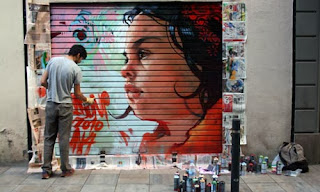Lately I have noticed an increase in Graffiti in my area, not the silly playground type. With their names and lists of loves, but a gentler almost innocent message. Akin to a John Lennon sentiment, these come in a variety of forms. All sharing the same message of giving love.




I must admit seeing them really does bring a smile to my face, illicit or not surely when the sentiment is taken into account it shouldn't matter. What difference does a few scribbles make in the grand scheme of life, when they promote such happy thoughts.
Apparently it means a great deal. To listen to people complaining, you could be forgiven for assuming that they contain a secret message from the devil. Yet these same people are the same to congratulate the messages when they claim vile truths about others. I find it a sad time when good is ridiculed over foul slander, but that seems to be all people can believe of graffiti.
These days when the subject of Graffiti comes up, it brings to mind teenage thugs with cans of spray paint 'tagging' their names and logo's. However this hasn't always been the case and the concept has been proven to have existed in Roman, Egyptian time periods. Even Vikings and Crusaders have dabbled in 'tagging', sharing their names across the centuries.
 The symbolism of illicit painting can be used as a social grading for the disgruntled masses, allowing an anonymous voice to be heard. British artist Banksy is a common example of a socially acceptable Graffiti artist. Whilst he is rarely seen, his artwork is still highly valued for its reflection on the political points of society. So notorious is his work, that his name is given to similar artists worldwide that use the technique to underscore their dissatisfaction with politics.
The symbolism of illicit painting can be used as a social grading for the disgruntled masses, allowing an anonymous voice to be heard. British artist Banksy is a common example of a socially acceptable Graffiti artist. Whilst he is rarely seen, his artwork is still highly valued for its reflection on the political points of society. So notorious is his work, that his name is given to similar artists worldwide that use the technique to underscore their dissatisfaction with politics.In the UK alone the suppression of art was historically penalized when the Anti-Social Behaviour Act of 2003 became Britain's latest anti-graffiti legislation. And again in 2004 when Prime Minister Tony Blair signed a charter which stated : 'Graffiti is not art, it's crime. On behalf of my constituents, I will do all I can to rid our community of this problem.' This was in support of the Keep Britain tidy campaign which issued a press release calling for zero tolerance of graffiti, supporting proposals for on the spot fines to graffiti offenders and banning the sale of aerosol paint to under sixteens.
However sometimes the art is simply art. If done on a canvas it would sell for hundreds or hang in a gallery, but being on a wall it it often ridiculed and dismissed as the efforts of a juvenile mind. I heartily disagree with the concept of public art, and believe that the efforts made by many countries to give over areas for Graffiti usage should be encouraged and broadened. Underpasses and bridges should be socially acceptable blank space used to showcase talent. Street walls should be set aside for annual examples by different artists.
After all shouldn't art be embraced in all its forms? Many exalted historical painters have seen their work banned or hidden due to a change in taste, and these now hang in museums and galleries. These days a wonky rubbish bin (Martin Boyce) and an unmade bed (Tracey Emin) can be Turner Prize Winners, so why not a refurbished wall. Look around you at all the spaces that could be made available to these suppliers of free art.

Imagine the colour they could bring to your little corner of the world.
Surely the world has bigger problems to address than artistic ideals.


On a side note the epidemic appears to be continuing into 2014. A lovely sentiment, I merely wish the author could point me in the direction of any I have missed!





No comments:
Post a Comment